Brand sentiment analysis is one of the most important metrics you have to keep your eye on.
Focusing solely on the numbers can be too narrow of a perspective. A great number of mentions doesn’t mean your brand is doing great. That’s because, in reality, the vast majority of those mentions could be terrible reviews.
? Read Brand Reputation 101: Monitoring, Analysis, and Management Tools
Getting the whole picture requires taking a deeper insight into your mentions.
Sentiment analysis provides context for your mentions and helps you understand your data.
In this blog, we’ll focus on defining brand sentiment analysis, defining automatic and manual sentiment analysis, explaining why you should pay attention to it, and show you how to do it with Determ.
What is Brand Sentiment Analysis?
Brand sentiment analysis is, to put it simply, a way of determining the general attitude toward your brand, product, or service.
Nowadays, the easiest way to analyze brand sentiment is through media monitoring tools.
The reason for using media monitoring is that people often express their opinions on social media channels. Since it’s impossible for you to manually search for every mention out there and evaluate it (especially if you’re a global brand), opting for media monitoring is a great way to go.
These types of tools analyze online mentions of your brand and give you insights on your brand’s position in the eyes of (potential) customers. The mention’s sentiment is determined as positive, negative, or neutral.
Keep in mind that the computer can’t detect sarcasm, for example, so the sentiment provided by the tool won’t be correct 100% of the time. But, it will give you a general overview of the sentiment trend. Later in the blog, we’ll show you what you can do to improve the correctness of the sentiment.
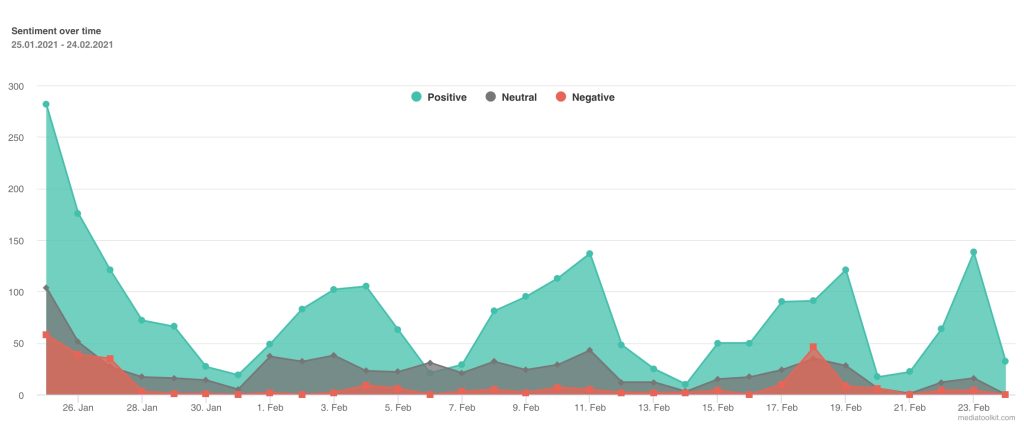
Why is Brand Sentiment Important?
Knowing your brand sentiment allows you to make informed decisions and work towards improving your business in general. Here we’ll show you 5 various aspects in which using sentiment analysis can be extremely beneficial:
1. Brand customer reviews
We already touched upon this subject in the previous paragraph. Social media, especially Twitter and Facebook, are filled with different opinions, reviews, and ratings on different topics, products, brands, people, you name it…
It often happens that someone mentions a specific brand, but doesn’t necessarily tag it in the post. That’s why it’s important to use media monitoring so you don’t miss out on the posts about your brand if the person writing it didn’t tag you.
Also, by tracking mentions all around the web and social media, you’ll be able to get a clearer and more realistic insight into your brand sentiment and get to know your customers better.
If you see that the mentions of your brand are turning more and more negative over time, it’s a clear signal something is off and you need to find the root of the problem and fix it. By doing so, you can avoid potential crises, losing customers, and damaging your brand.
Read Meeting Customer Needs: 7 Ways to Get to Know Your Customers Better
2. Crisis detection and mitigation
No one is immune to crises, and PwC’s research from 2019 proves that. According to them, 69% of participants experienced a crisis in the last five years.
Sentiment plays two important roles in crisis situations.
Firstly, the sentiment is a reliable indicator of a potential crisis in the making.
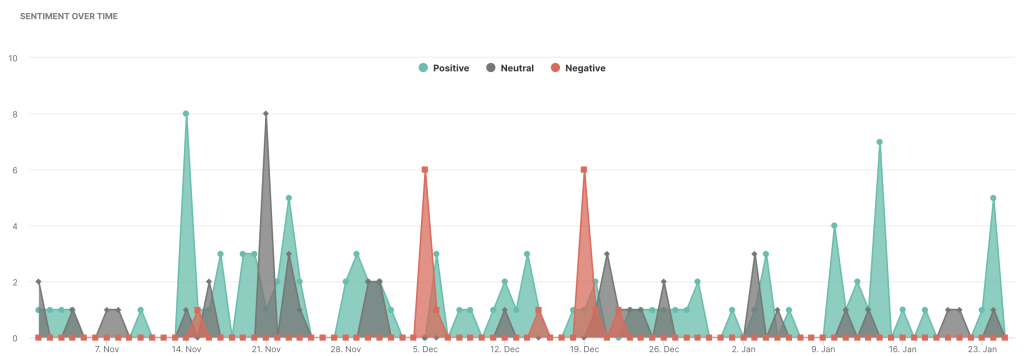
If you notice your sentiment growing increasingly negative in a short period of time, you should start preparing a crisis communication strategy or implementing the existing one.
The great thing is that media monitoring tools notify you in real-time if the number of (negative) mentions starts growing unexpectedly, so you don’t have to go and check it every minute.
Secondly, if you’re in the middle of a crisis, sentiment analysis will show you whether your mitigation efforts are working or not. If you see the mention’s sentiment going more towards neutral and positive, it means you’re doing a good job!
3. Campaign performance analysis
Did your target audience like your campaign or not? By analyzing sentiment you can get the answers you’re looking for.
What’s more, just as during the crisis, it’s wise to monitor how the sentiment changes during your campaign. By regularly doing sentiment analysis, you’ll easily catch new trends, ups and downs, in how the audience perceives your campaign. This way, if you notice a rise in negative mentions, you’ll know immediately and can react quickly. Response time always matters. The sooner you notice a dip in positive reactions, the sooner you can get to the root of the problem and adjust your response accordingly. Monitoring a campaign is a full-time job that requires keeping up with the results and audience reactions. Sentiment analysis is just one of the metrics helping you keep up.
Analyzing sentiment can be great for finding influencers, and by collaborating with them you can boost your campaign performance. It is estimated that 49% of consumers depend on influencers’ recommendations on social media, so you better find the right influencers to help you out.
Read Campaign Tracking: How to Monitor your Marketing Efforts with Determ?
4. Key people in your company
When monitoring mentions of your brand, it is important to monitor mentions about key people in the company as well. Unfortunately, it often happens that one failed interview with a CEO causes a lot of problems for the company itself.
That’s why you should keep an eye on the sentiment after big interviews or articles come out, so you can see how people are reacting to them.
5. Competitive analysis
Monitoring competitors’ brand sentiment with competitor analysis is as important as monitoring your own.
Use sentiment analysis to explore what your competitors are doing right, and what they’re doing wrong and find opportunities in that.
For example, if a competitor’s customers are unsatisfied with a product or service, and are posting about it online, it can be a great opportunity for you to suggest to them your product or service instead. You just might get a new customer!
Also, you can examine competitors’ mistakes, and learn from them so you don’t repeat them.
One thing that can help you achieve more positive brand sentiment and better results regardless of the amount of competition around you is establishing a brand voice.
Make sure you get to know your target audience well, so you can communicate with them in a way they’ll appreciate. By doing so, you’ll be able to establish successful long-term quality relationships with your customers which will keep your brand sentiment on positive levels.
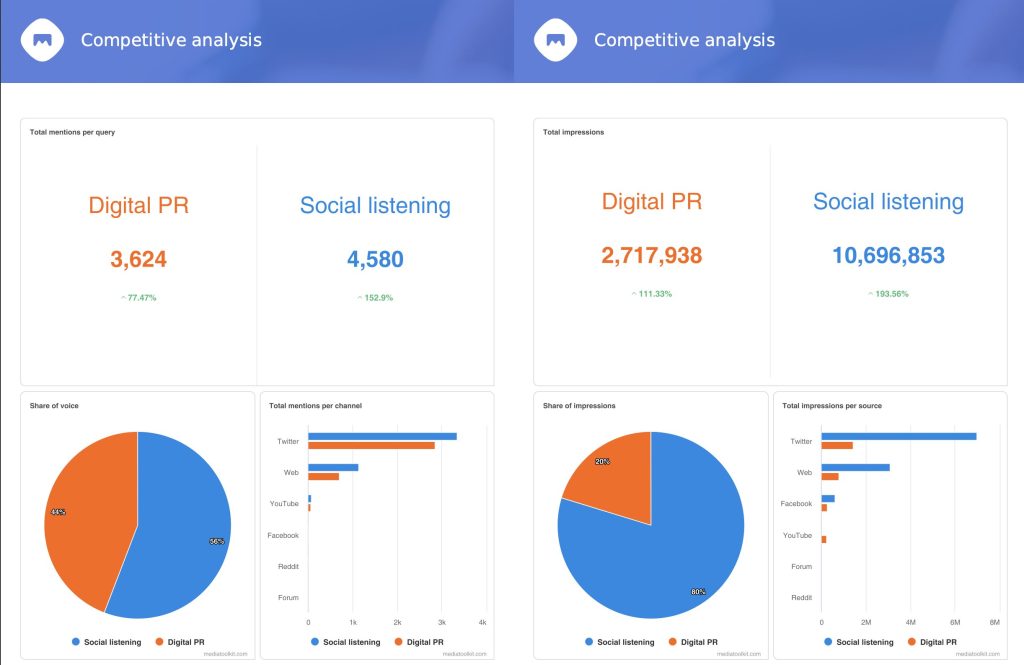
How to Improve Brand Sentiment?
If you found yourself in a bit of a pickle, and your brand sentiment analysis is more on the red side, there’s a couple of things you can do to make things right.
Listen to clients’ feedback
Paying attention to clients’ feedback is something that you should absolutely do. But you should also be careful not to fall into a trap of wanting the perfect feedback from each and every customer.
Something will go wrong from time to time, and a customer or two might complain. Your job is to react swiftly and accordingly to resolve the situation.
Even if a customer leaves a negative review that is not truthful, you should respond politely because other (potential) customers are watching.
Plus, the reason you shouldn’t strive for a perfect score is that studies show that customers become suspicious when they can’t find a single negative review about the brand.
Read 10 Steps to Manage Negative Online Reviews
Change things
If there’s an issue that constantly pops up in relation to your brand (e.g. slow customer service, faulty products, etc.) you need to put in some work and fix it because the status quo will not serve you in the long run.
The same goes for your PR and marketing efforts. If, for example, your last marketing campaign received a negative reaction from the public, learn from the experience, and do better in the future.
Get to know your customers and adjust your communication efforts to their needs and preferences.
Don’t wait for too long
Keep in mind that most issues won’t magically disappear by themselves. The more time you spend ignoring the issues, the more likely your brand reputation will suffer.
If your brand sentiment analysis is showing you increasing negative sentiment, you have to react. As we mentioned before, if you let negativity around your brand run wild, you’re probably heading toward a crisis.
Make sure you’re solving issues as they arise to keep your customers happy, and brand sentiment untacked.
Be proactive
Don’t wait for things (aka positive brand sentiment) to happen to you. Be proactive and offer your customers something that they’ll benefit from and appreciate.
Whether it’s educational content, UGC campaigns, tips & tricks, or something else, make sure you delight your customers and establish great relationships with them.
What Types of Sentiment Analysis are There?
We can generally identify three main types of sentiment analysis: automatic, manual, and effective sentiment analysis.
Below we discuss each sentiment analysis separately.
Automatic sentiment analysis
Automatic sentiment analysis relies on processes like natural language processing, text analysis, and computational linguistics to detect the correct sentiment of your mentions.
Based on the expressions used in the text of the mention, the tool will detect whether the words considered to be positive or negative prevail and then allocate the matching sentiment. In case neither positive nor negative sentiment is predominant, a neutral sentiment will be assigned.
As the name suggests, the process is fully automated. The tool will conduct the sentiment analysis as soon as it starts tracking your query. As a result, while browsing through the tool feed, you will see a dotted line indicating the sentiment on the very left of every mention.
Shown below is an example for every type of sentiment:
- grey for neutral,
- green for positive,
- and red for negative.
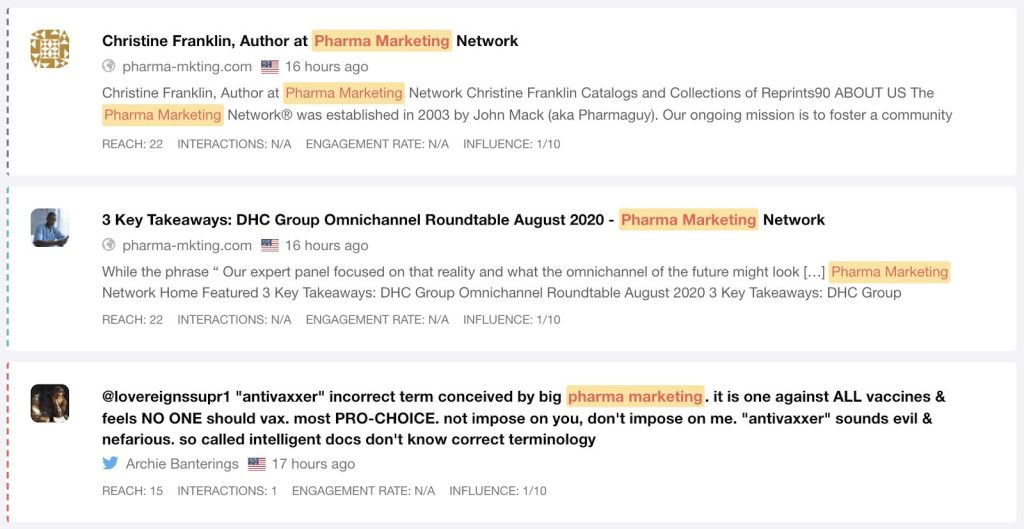
Notice the mention marked as negative. That is because it contains words evil and nefarious that have a negative connotation. Now, depending on your stance on vaccination, this mention might not be negative to you, despite the usage of the aforementioned words.
This applies to any topic out there – your own perspective on it might not always be aligned with the automatically assigned sentiment. That is simply the human nature element computers still can’t compete with, regardless of how advanced machine learning is.
Factors that affect automatic sentiment’s accuracy
Lack of context
Analyzing sentiment out of context can be pretty tricky. Especially as it can lean to one extreme or another, positive or negative. Take a look at this example:
Nothing at all.
Now, out of context, it would be rather challenging to determine the sentiment. Out of context, we might lean more towards the negative sentiment than the positive. However, what if the question preceding the answer was:
What did you dislike about your experience with our customer service?
The sentence “Nothing at all.” gains a whole new meaning. It indicates that the person liked their experience, or rather did not dislike it – taking on positive sentiment.
Sarcasm & irony
Again, this can largely depend on the context and is often distinguished best when spoken by the inflection in a person’s voice. So, while the written word may seem positive, it’s actually mocking. People use positive words to express their negative sentiment, and that can be difficult to detect for machines:
Oh yeah, so polite.
It’s totally fine our reservations were canceled.
Now, this may very well be positive, right? Machines have no textual clues to help them detect sarcasm or irony, especially as the words used are so polite and totally fine, which have positive connotations.
Oppositional conjunctions
What if a sentence contains both a positive and negative sentiment? That can occur when a piece of text consists of two opposing, contrasting words – one positive and one negative:
Their customer service is terrible, but their tool is great.
In general, the automatic sentiment analysis boasts 70-80% accuracy. But, in situations where you want that percentage to be even higher, manually adjusting the sentiment of your mentions is the solution.
So, if you’re looking for a fail-safe way to get the most precise, relevant, and reliable sentiment analysis – you’ll do it yourself.

Manual sentiment analysis
You’re the one that’s best familiar with the context your queries appear in. That’s why you are capable of discerning genuine commentary from sarcastic/ironic commentary. Sometimes, a little manual sentiment analysis and correction can go a long way.
It might take some time, but the resulting analysis will be more accurate.
As it stands, our tool offers both automatic and manual sentiment analysis. Here’s how you can easily manually change the sentiment of your mentions if you feel it’s necessary:
Step 1: Go to your feed
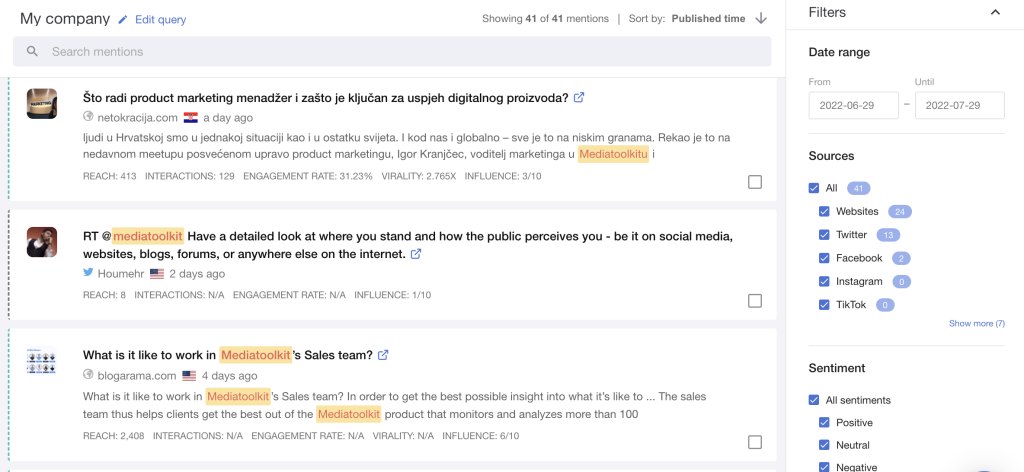
Step 2: Manually select the mention whose sentiment you want to change
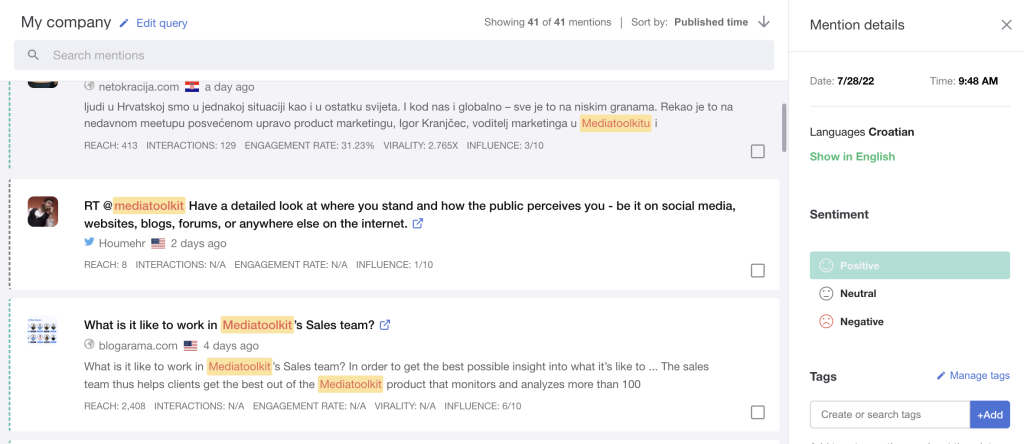
Step 3: Choose the fitting sentiment (positive, neutral, negative)
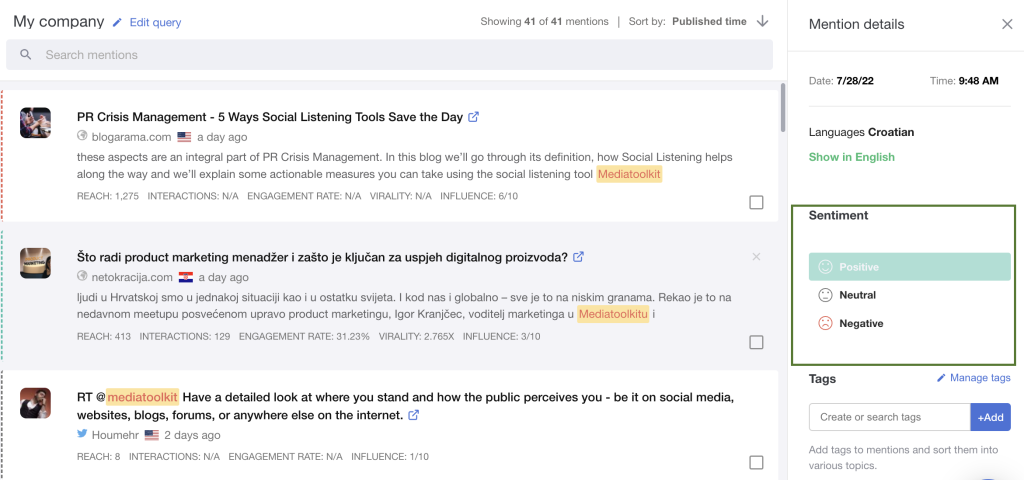
Effective sentiment
In essence, the effective sentiment is exactly what we described above. It is a mix of both automatic and manual sentiment analysis.
How to Do Brand Sentiment Analysis with Determ?
From setting up queries to various charts, here’s how you can use Determ to get the best out of your sentiment analysis:
Setting up queries
The first step is to set up a query containing the keyword(s) you want to track. To get better results, use Boolean operators, source, location, and language filters.
After you’ve done that, the results will show in your feed.
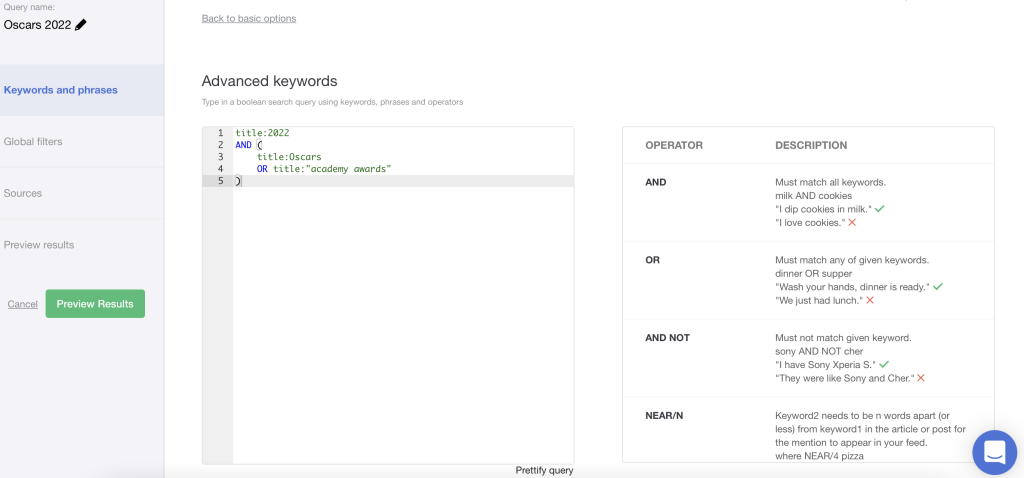
Automate your sentiment
If you’re expecting to gather a lot of mentions with your query, or you simply want to automate the media monitoring process as much as possible, the best thing to do is to set up Automated actions.
With this feature, you can assign specific sentiment to future (and old) mentions by setting up words, sources, and/or websites that will trigger that action.
For example, let’s say your brand is going through a scandal called “xygate”. What you can do is set all mentions containing “xygate” as negative.
That way you won’t have to worry about the tool misinterpreting the sentiment and manually change sentiment later.
Automating as much of your tasks as possible will allow you to focus on more important things and improve your efficiency.
Check out sentiment charts in the Reports
Alongside charts like mentions over time, total impressions, locations, languages, etc., Determ has five charts with sentiment data in the Advanced reports.
The first one is the Positive-negative sentiment ratio. This chart is a quick and simple way of seeing the predominant brand sentiment.
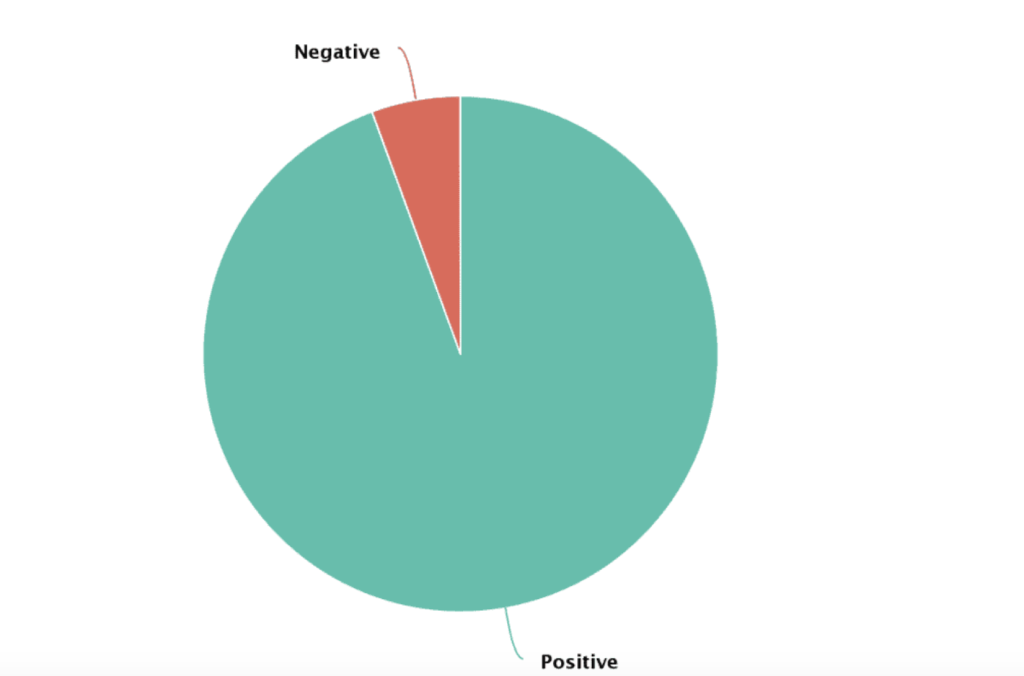
The second one is the Sentiment ratio that includes positive, negative, and neutral sentiment.
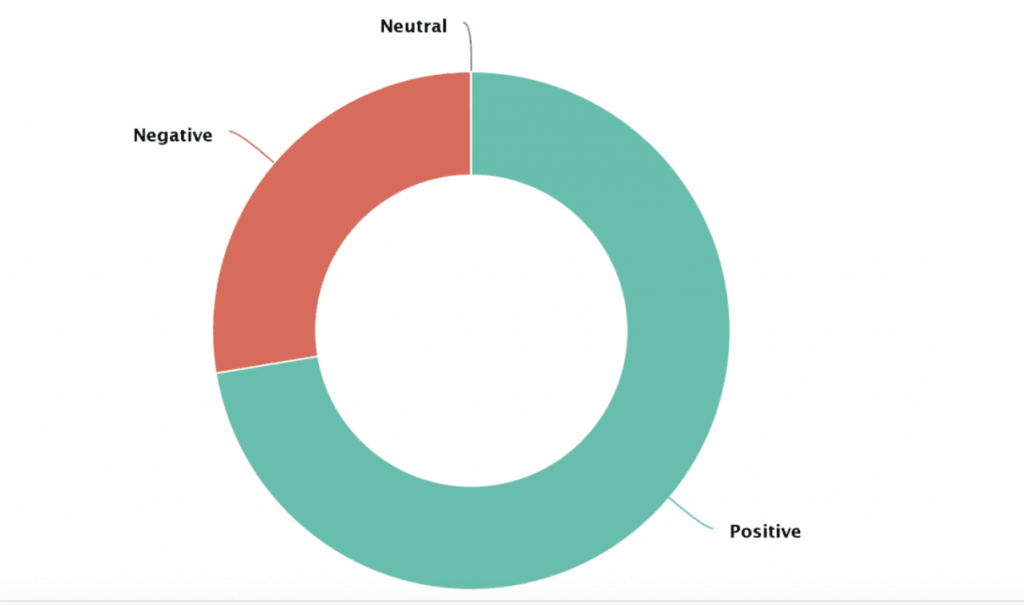
Following up is the Sentiment ratio by channel chart. This chart will show you the brand sentiment depending on the channels you are monitoring.
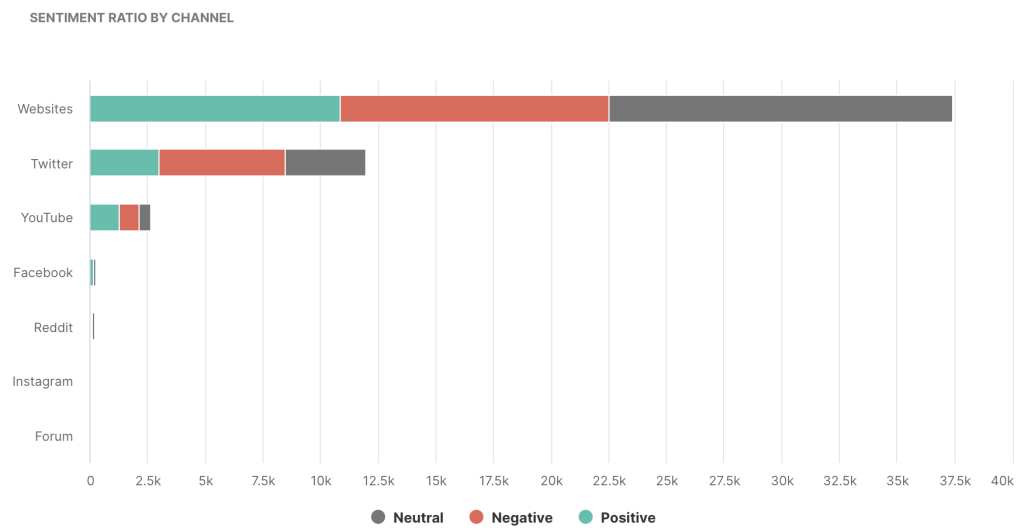
Next, the Top influencers by sentiment chart will enable you to see which users are the most active mentioning your keyword, both for positive and for negative sentiment.
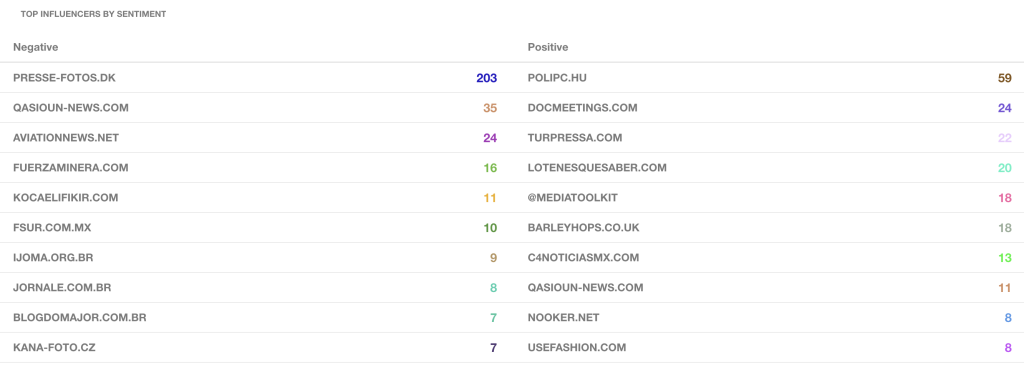
Finally, there is the Sentiment over time chart. This chart will allow you to see how your brand sentiment is changing over time.
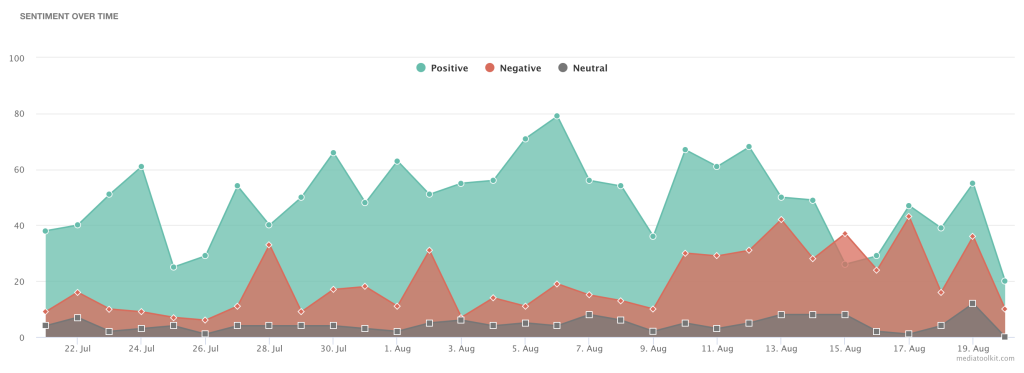
With the reports, you can constantly be up-to-date with your brand sentiment and download them when necessary. You can export your data in the form of a PDF, .xls, or .ppt.
Also, you can create custom reports and charts so you can focus only on data relevant to your business.
Remember when we talked about different types of sentiment?
While creating custom charts, you’ll be able to choose what type of sentiment you want to have in the chart. If you want a general overview, choose automated sentiment. The effective sentiment is great for daily reports, while manual sentiment provides you with the most accurate data.
Final Thoughts
Brand sentiment analysis will provide you with valuable insight into customers’ perceptions of your brand. That type of feedback will help you improve your brand and keep you out of trouble.
Nowadays, the quality of the product is not the only thing that matters. Brand reputation and values play an important role as well. More and more, customers are realizing that they hold power by choosing where they spend their money. And that choice is often influenced by the brand’s position on certain topics. 57% of millennial women say that their purchase decisions are driven by a brand’s values and stance on issues that are important to them.
Media monitoring can help you understand your customers’ wants and needs better, and put you on the right side of issues.



